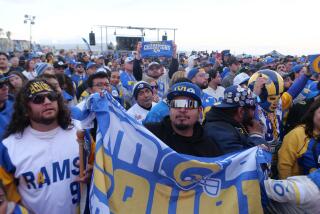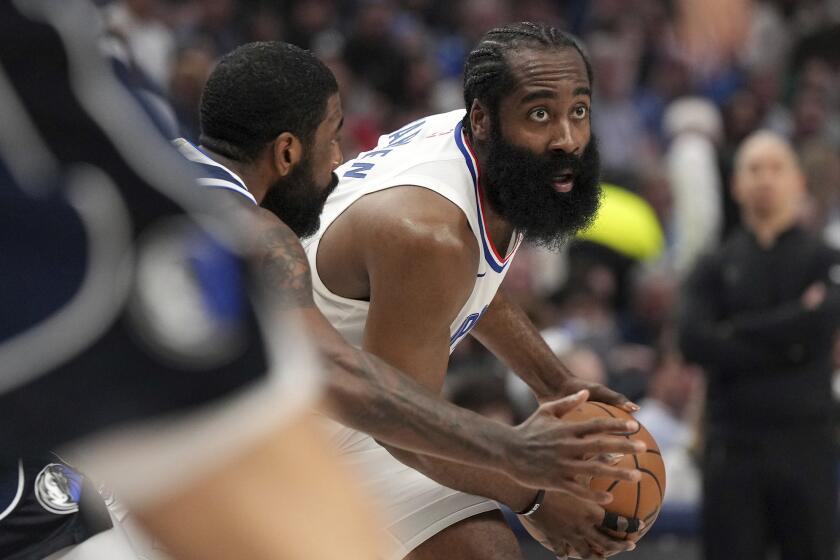POWER TRIP
Hitting a home run is hard. No, honestly, it really is.
This season, Mark McGwire and Sammy Sosa have made hitting homers look almost ridiculously easy. Yet for generations, no feat in American sports has been regarded as more difficult than hitting a major league pitch over a distant fence.
In big league dugouts, the feats of McGwire and Sosa have been met with even more amazement than you’ll find in the bleachers or press box. Ballplayers know the true difficulty of the task. And their jaws are slack.
This week in Baltimore, there were what amounted to nightly symposia on The Home Run as some of the best sluggers of recent times gathered for the series between the Orioles and White Sox. As Chicago’s Frank Thomas put it, “Mark and Sammy are making it look simple. But it’s not. To hit a home run, so many things have to be perfect .”
A slugger needs strength and quickness, excellent eyesight and magic hand-eye coordination, plus an almost total fearlessness--a crazy obliviousness--in the face of pitches going 95 mph. But that’s only a set of minimum requirements. There’s so much more.
“You have to get a perfect pitch. Your timing has to be perfect. And you have to hit the ball with a great swing. That’s not an easy thing to do on an everyday basis,” Thomas said. And “The Big Hurt” would definitely know. Over the past seven seasons, he hit .330 and averaged 36 homers and 117 RBI. He was the rightful statistical heir to Ted Williams, the man who claimed hitting a baseball was the toughest act in sports. This season, Thomas is hitting .256, with 25 homers. Why?
“It’s hard ,” Thomas said, plaintively.
Why, in particular, is it hard to hit home runs?
Oriole Eric Davis, who has 264 career homers, opened his mouth to answer the question when eavesdropping teammate Harold Baines, who has 346 homers, pulled rank and interrupted.
“Because you don’t try,” Baines said. Then they both laughed.
“When I’m hitting for power at my best, I’m almost trying not to,” said Brady Anderson, who hit 50 homers two years ago.
That’s part of the Zen-master trick of slugging. Physicists say that, to hit a home run, you hit the ball so hard that it has the effect of an elephant standing on the ball. Yet, even McGwire said last week, “You should never feel like you’re swinging hard.”
“It takes an awful lot of being relaxed to see the pitch well and not spoil it by trying to hit it too hard,” said Oriole coach Eddie Murray, who has 504 career homers. “The more you try [to hit a homer], the harder it is. Just look at my stats going for No. 500 [in 1996].
“I can still see those orange signs,” said Murray, throwing his hands in front of his face in mock horror at the memory of the Oriole Park stands with signs calling for No. 500. “I’d think, ‘Oh, no, they don’t want just a hit.’ ”
Sosa, according to some of his teammates, has found a unique solution to this problem. Every swing he takes is designed to produce a home run, not “just a hit.” Perhaps more than any other hitter, Sosa refuses to compromise the force--and especially the perfect balance--of his swing just for the sake of making contact. He couldn’t care less how often he strikes out. And he fanned 174 times in 1997 (139 times so far this year). What matters is identifying the pitch, taking a hard but controlled uppercut swing and accepting the results. Even if he misses the ball by a foot.
“When I broke in, a strikeout was bad. Now, for a slugger, it’s just another out. The game’s changed,” said 382-homer man Cal Ripken.
Personal quirks of hitting style can dictate a slugger’s level of success. “If Cal had an uppercut swing, he’d be closing in on 500 homers, not 400,” Davis said. “Rip has hit hundreds of the hardest singles to left field that you’ll ever see,” Anderson said. “But he’s never been able to elevate the ball consistently.”
Some great hitters overcome a natural line-drive swing to become sluggers. “Barry Bonds and Juan Gonzalez are like that,” Davis said. Others, like Thomas, have the gift of backspin that helps the ball carry farther as it flies. “But Albert Belle has an even more perfect home run swing than Thomas,” Anderson said.
“Yeah, you should talk to Albert about this,” said Ripken, slyly, knowing how Belle loves to snub reporters. “He’s very smart about mechanics.”
Hello, Albert. Cal said you can be of help. (Albert turns his back and refuses to shake hands.) Cal said you understand the mechanics of the proper home run swing. Any thoughts?
Belle, who has 314 home runs, picks up his bat and, without speaking, goes to the center of the locker room. There, he very slowly takes a couple of dozen perfectly balanced, precise yet violent practice swings.
Is this rudeness? Is this an answer? Is it both?
“Balance. Right, Albert? That’s your point?”
No answer.
“Thanks.”
Part of the mystique of home run hitting is that no two players can agree--entirely--on how you achieve that combination of precision and violence, balance and abandon.
“The home run swing is not a strength move,” said Anderson, who has studied other sports from track to weightlifting. Anderson compared the proper home run move to the “fast and explosive” clean-and-jerk in weightlifting, as opposed to the brute force used by power-lifters.
“It helps to be big,” Anderson said. “Almost every home run hitter is over 200 pounds. Don’t tell me Willie Mays and Hank Aaron weren’t. It’s a lie. Everybody in baseball goes by their weight when they first sign. You think we don’t get bigger? But it’s not just size. I played against McGwire in college. He was tall and skinny then. But he already had amazing power.
“What matters is your ability to sum up your forces, sum up your parts,” added Anderson. Most players just can’t do it. “We once had a big catcher named Jeff Tackett. So strong. He could crush you with his hands. But he had no power. Couldn’t sum up his forces.”
Pound for pound, the longest hitter of current times may be the rod-thin, 200-pound Davis, who hits balls farther than any Oriole. In his early days, Davis launched homers that Pete Rose said were the longest he’d ever seen to the opposite field by a right-handed hitter.
“You have to find a way to load up . To do that, you need to be strong in the hands and the legs,” said Davis, who’s constantly trying to find triggers to unleash the sum of his forces. “You’re legs are like the accelerator of your car. You hit the gas,” he said, taking a stride, “and, ‘Rrrrrrrrrgghhh.’ ”
When you start those legs, however, you have to “leave your hands behind” in the parlance of hitters. “To get power, the stride and the swing itself have to be two different parts,” Anderson said.
To help keep a sense of demarcation between the two--so they don’t contaminate each other--many sluggers use a high-step approach, made famous first by Mel Ott and, later, Japan’s Sadaharu Oh. Now, Sosa uses it.
“Last year,” Davis said, “I started copying the leg kick from . . . “
“From Harold Baines,” said Harold Baines. “Tell the man the truth.”
“That’s right,” Davis said, “and I stripped you of your powers .”
Luckily, those powers are, and always have been, somewhat mysterious in baseball. Everybody knows that, if you can hit just 30 or more home runs a season, you can earn $5 million to $10 million a year. Yet only a couple of dozen people in the world are able to accomplish it. Those people can arrive in all sizes--from McGwire’s 250 pounds to Sosa’s 200. And in every conceivable style.
“Jeff Bagwell strides backward,” Anderson said. “He’s got to be the only player who’s ever done that.”
Players themselves tend to be most in awe of the sluggers who seem to perform their act effortlessly, like Ken Griffey Jr. and Alex Rodriguez of Seattle. “They have so much bat speed through the hitting zone, then follow through long, high and slow,” Anderson said.
In a sense, what baseball has at the moment is a spectacular amalgam of classic slugging components: His name is McGwire. He doesn’t care if he strikes out. Yet he doesn’t overswing. McGwire sums up his forces. And his forces are preposterous.
No wonder it looks so easy. Even though nothing in sports is harder.
More to Read
Get our high school sports newsletter
Prep Rally is devoted to the SoCal high school sports experience, bringing you scores, stories and a behind-the-scenes look at what makes prep sports so popular.
You may occasionally receive promotional content from the Los Angeles Times.






